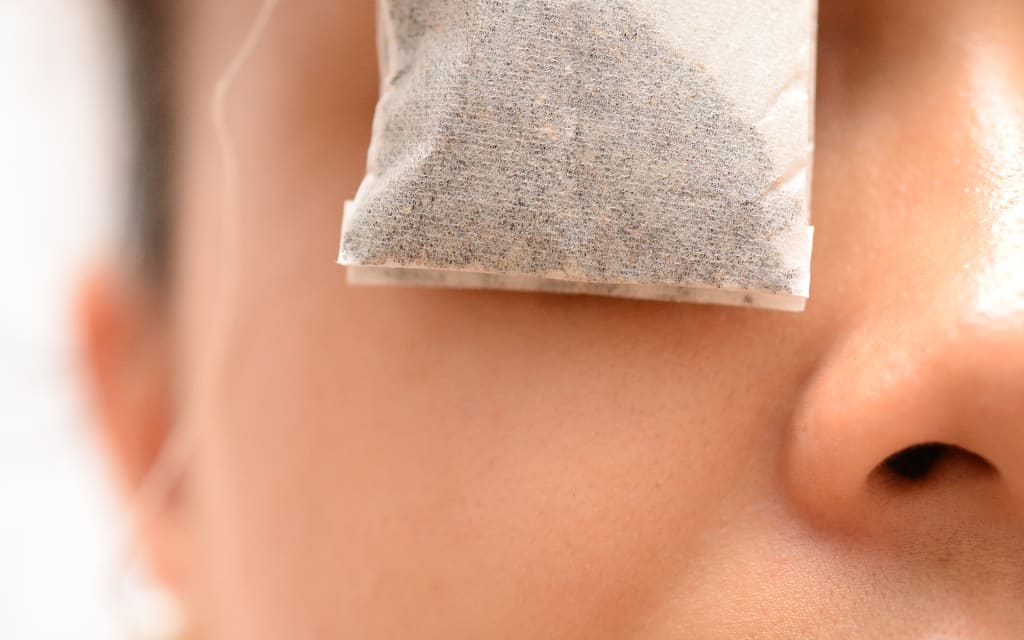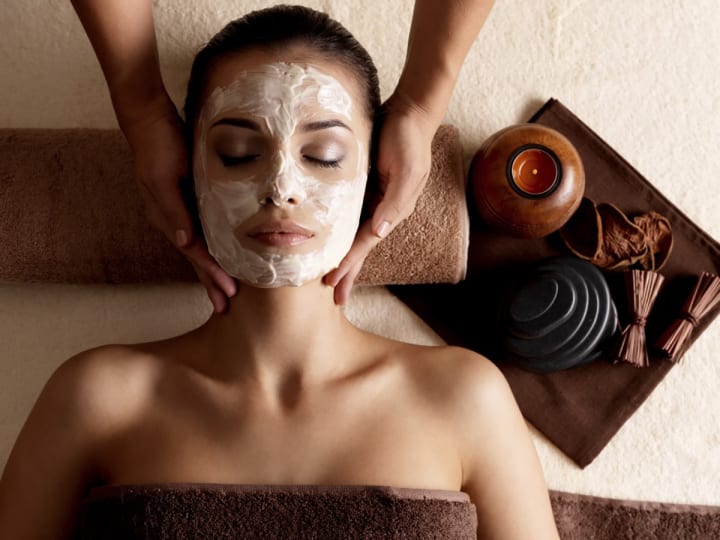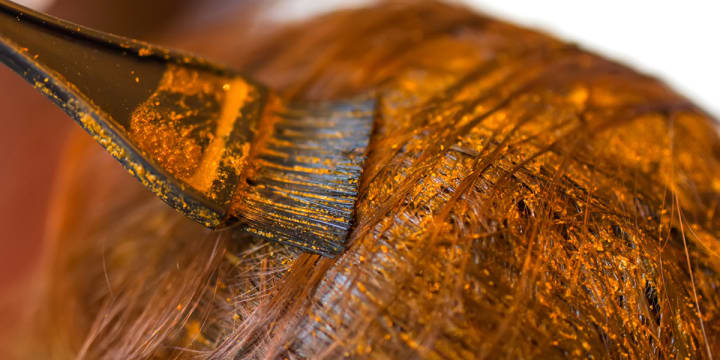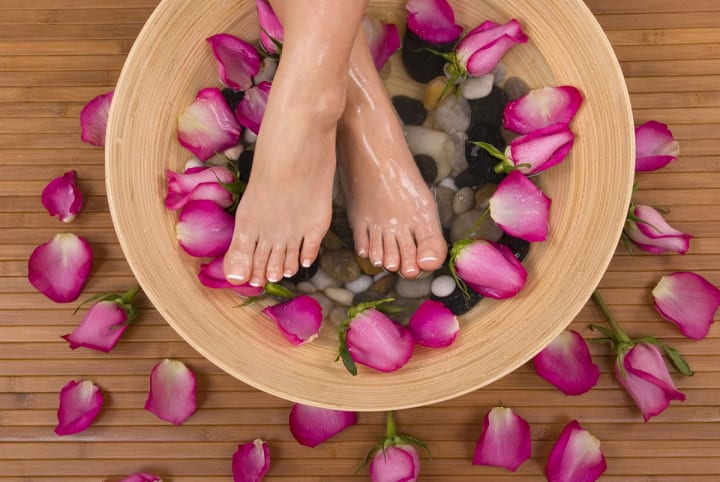Natural Home Beauty Tips
A few carefully chosen items and some natural home beauty tips will keep you looking fresh.

Shopping for beauty supplies in a supermarket is something you'll find a lot of people doing these days whether it's for the brand names or the basic ingredients for making your own at home. Since the natural look is in, a few carefully chosen items, such as avocados, tomatoes, cucumbers, yogurt, and tea bags, will keep you looking fresh.
Take the lowly tea bag, for example. If your baby blues are red and puffy from a hard day at work, moisten a pair of tea bags and lay them on your eyes. The tannic acid in tea has natural astringent qualities that help reduce the puffiness and stop the itching. If you're fresh out of tea bags, raw cucumbers or pieces of potato do nicely as cool compresses to help sore eyes. All you do is slice them and lay them directly on your eyes while you lie down and relax for five minutes. If the idea of raw vegetables sitting on your face turns you off, puree them and wrap the pulp in cheesecloth bags. The soothing effect is the same.
It does, however, take more than clear eyes to look your best; and that's where some knowledge of what natural products do to different kinds of skin really comes in handy. Obviously, there's a big difference between treatments for dry, oily, and normal skin. There's also a big difference between the products you use for each of these conditions.
Fruits and Vegetables for Skin Care

For people with oily skin, there's nothing like tomatoes and strawberries. They're both acidic and help cut the skin's pH level. These same ingredients would wreak havoc with dry skin. You'd feel as if your entire face had cracked and was about to fall off from your head. Avocado is the magic fruit for dry skin. They've got a high oil content and help the skin retain moisture. Normal skin, of course, can tolerate anything but steel wool—ranging from buttermilk to yogurt to egg yolks.
Generally, though, highly acidic fruits and vegetables are better for oily skin, while fruits and vegetables with low acidic content or high oil content are terrific for dry skin. For those of you blessed with normal skin—well, the sky is the limit, so to speak. Just keep in mind that even when a product is theoretically "right" for you, drop it like a hot potato if you find that it's irritating the very thing you're trying to improve.
Face Mask

Everybody can benefit from using a face mask once a week. They help you get rid of oil and built-up accumulations of dirt and grime, as well as slough off dried skin—all of which can make you look about as dull as a board. Just 20 minutes a week under a face mask will have your skin glowing with vigor and health.
Using a face mask is easy. Decide which mask is best for you, mix it up, and apply the mask to clean, damp skin. Remember, spread the mixture on evenly and avoid the delicate areas around your eyes. When you're finished, moisten some tea bags, put them on your eyes, lie down, and let Mother Nature do the rest. Use tepid water to remove the mask. To complete the treatment, apply a coat of moisturizer to your face.
One of the best face masks for dry skin is made from avocado. Blend the meat of one ripe fruit with one tablespoon of honey until it's smooth. Or, if you're fresh out of avocados, a banana blended with half its peel and a tablespoon of honey will work just as well. If you find that some ape has eaten your last banana, there's always the ripe-apricot trick. Mix three with equal amounts of powdered milk and honey. It smells great and it's a mask that anyone with dry skin will welcome.
Tomatoes. Is there nothing they can't do? Especially if you've got oily skin. Just liquefy one ripe love fruit, as they were once called, pat it on your face, and leave it on for 20 minutes. If you've used all your tomatoes in a salad, two cored apples blended with one tablespoon of lemon juice will do the trick. If apples are out of season, Marie Antoinette had a formula for days when she thought her skin too oily. Put one ounce of cognac, one ounce of milk, a raw egg, and the juice of a lemon into a pan and heat it until it's just barely warm. Pat the mixture on your face and let it work its wonders.
Anyone with normal skin can use just about any kind of mask she cares to concoct. You might try mixing one cup of buttermilk with the juice of one lemon—its natural bleaching qualities make it especially good when your tan is fading. Or mix one cup of plain yogurt with almost any kind of fruit: peaches, apricots, or blueberries, for example. Two egg yolks beaten with two tablespoons of honey and three drops of almond oil is another brew that works well for normal skin.
Once you've tried a natural face mask, you'll like it and want to do it again. And no matter how tempting your face mask looks, don't eat it—for once, a little egg on your face might be just what the doctor ordered.
Hair Coloring

Henna has been with us for a long time—centuries, in fact. The next time you find yourself standing next to an Egyptian mummy, have a good look at her hair. You'll see that it's dyed with henna. Ditto the ladies from the mysterious Middle East. And when it came time for women of the harem to whisper a little something into their sultan's ear, they painted exotic, erotic messages on their toenails with the dye. Today, it's used by people to paint designs on the entire foot—for beauty's sake.
There are some very good reasons to use henna. For one thing, it's a natural product—it comes from the leaves of a small shrub. For another, it doesn't damage either the hair or the scalp. Instead of penetrating the hair shaft, it simply coats it with color, thereby adding body to your hair. And it has lasting qualities—one treatment will last as long as three months.
Henna comes in powder form, so it needs to be mixed to a paste before it's applied to your hair. And remember, while at one time there was only one shade of the dye, there's still only one that's entirely "natural," and that's "Egyptian' or "natural," the other shades—black, brown, red, and blond—all have chemicals added to them.
Natural henna will bring out auburn highlights in light brown hair, turn brown hair deep mahogany, and bring out the natural highlights in dark hair. Some hair takes on a brassy tint from henna. To avoid this, instant coffee can be mixed with the henna powder. Or, if you want a bright, coppery color, you can add some vinegar to the henna. The various shades of henna that can be bought can be added to natural henna to tone the red in it, or to bring out other tints your hair might have. No matter what kind of henna you decide to use, the coloring process is the same for all.
- Mix the henna powder with water to make a paste. Add coffee to it to minimize brassy tints, if desired.
- Apply the henna paste to clean, wet hair. Make sure it is combed through evenly.
- Wrap a towel around your head (use an old one you can throw out afterward), and let the henna remain on your hair for 45 to 50 minutes, depending upon how deep an effect is desired.
- Shampoo the henna out and dry hair as usual.
The only major problem you'll find with using henna is that it stains things like hands, towels, bathtubs. But don't kid yourself into thinking that henna is any less messy when used in a beauty salon. The only difference is that there, at least, there's someone else to clean up the mess. Don't despair, though. There's someone who sympathizes with henna users and understands how easy it is to hate something you love so much.
Henna's coloring properties don't work well on all hair. Most blonds spend their lives looking for ways to lighten their hair, not bring out darker red highlights. One trick that European women have known for years is that chamomile can be used as a natural dye. The process is much like using henna.
- Mix four tablespoons of chamomile flowers with one cup of water. Let stand for 20 minutes.
- Mix the infusion with kaolin (a white clay) to make a paste.
- Apply the paste to clean, wet hair. Comb through.
- Leave the paste on your hair for 20 to 60 minutes, depending upon how light a color you want.
- Wash out and dry hair as usual.
If you are more interested in temporary rinses for your hair than in permanent color, there are many herbs that can be infused with water and used to bring out natural highlights.
For blond hair a mild infusion of chamomile works well, as do marigolds. If you have the patience to pick enough flowers to get five tablespoons worth, mix them with two cups of water to be used as a rinse. Lemon juice, diluted with water eight to one, is another well-known rinse for blonds.
If your hair is dark, you might want to try an infusion of rosemary to add luster to your hair. Vinegar, diluted with water eight to one, brings out natural highlights and helps maintain the proper pH level of the scalp. Stale beer or stale champagne can be used as a rinse to make hair more manageable. Don't worry about the odor—it disappears, so that no one will have any idea of what you did to get such beautiful hair.
If you want to go one step farther than henna, chamomile, or herbal rinses, you might want to consider your hair an accessory and try another natural coloring technique.
If you're ready to make a drastic change in your hair color, try this technique at home. You'll need natural vegetable dyes (food coloring), a commercial hair lightener, and conditioning cream or barrier cream.
- Decide what parts of your hair you want colored, and what color you want to dye them.
- Apply a barrier cream or hair-conditioning cream to those locks of hair, except for the one-half inch at the tip.
- Wrap the rest of the lock of hair in tinfoil or cotton batting to protect it from the dye.
- Mix a commercial hair lightener according to the package directions and place it on the tips of the hair to be colored. Leave it on for 30 minutes, then carefully shampoo the tips of the hair only.
- Put vegetable dye (food coloring) on the tips of the hair and let it remain for fifteen to twenty minutes.
- Unwrap the foil or cotton and wash hair. The tips will be colored while the rest of the hair will be its normal color.
The vegetable dye will remain effective in your hair for about three weeks. As it fades, more dye should be applied. You can use the same color or change colors to match different clothes. If you get tired of the colored tips, you'll have to cut them out. It's a big decision to make this kind of change in your hair, so think it through before you begin.
Hair coloring isn't for everyone. If you want some sort of change but a new color is too drastic for you, consider a new haircut or using accessories more imaginatively. And look into your health patterns to make sure you're doing everything possible to have a healthy head of hair. If you get plenty of sleep, eat a balanced diet, and get fresh air and exercise, it will show in your hair. It will be shiny, bouncy, and vibrant. Men love to run their fingers through hair like that. Take time to get your hair into shape. It's a wonderfully sexy feeling, and it can be yours.
Feet First

When talk turns to erogenous zones, feet are probably the last things that leap to most people's minds. But the fact of the matter is that they are erotic, and everyone from the ancient Egyptians to Casanova, Sigmund Freud, and Sherlock Holmes' smarter brother knew it. No less than Ovid, pontificating before an audience of young Roman would-be lovers, observed, "Lose no opportunity for establishing secret contact between feet and hands" at the dinner table. It's rumored that Cleopatra got it on with Mark Antony because of her beautiful feet. And Kurt Vonnegut, late of Tralfamadore, introduced the world to a new kind of sex with his "boko-maru"—two people communing with each other's souls by lying flat on their respective backs and pressing the soles of their feet together.
When Leonardo da Vinci said that the foot was "a masterpiece of engineering," he knew what he was talking about. Its nomenclature is impressive: 26 bones, 120 ligaments, and some 20 muscles. It's rich in its concentration of nerve endings and makes more contact with the real world than any other part of the body. When you stand, walk, run, or dance, your feet support your weight and absorb its impact. To do all that—and stay sexy too—is no small feat; and taking the time to pamper yours is an idea that makes more than a little sense.
Warm-up: Stand with your feet about 6" apart, toes pointing straight ahead. Bend your right knee, allowing the right heel to come off the floor. Place your weight on the ball of your right foot. Continue stretching the right foot until only your big toe is resting on the floor. Slowly put the weight back on the ball of the foot, then lower the heel and return your foot to the starting position. Repeat the stretch four times with the right foot and four times with the left foot.
To strengthen ankles and arches: Scatter a dozen coins on a carpeted floor and pick them up, one by one, with your toes.
To strengthen the bottoms of the feet: Place a rolling pin on the floor and roll it under your foot, back and forth, feeling the stretch from heel to toe. "Roll" each foot for about two minutes. Wear socks so that you don't get splinters.
For ankle flexibility: While sitting, rotate your foot from the ankle, four times clockwise, then four times counterclockwise. Repeat two times with each foot.
Pedicures keep your feet healthy and beautiful. They remove calluses, smooth skin, and make your toes a treat to look at. Once a week isn't too often to give yourself a pedicure at home. If you can afford it, a professional pedicure once a month is a wonderful luxury. In between pedicures don't ignore your feet. Bathe them daily and apply moisturizing body lotion to them after your bath or shower.
You can easily give yourself a pedicure at home if you follow a basic routine.
Time: About one hour
Tools:
- Nail clipper
- Orange stick
- Cotton
- Pumice stone
- Body cream
- Cuticle cream
- Emery board
- Polish remover
- Base coat
- Colored polish
- Top coat
- Soak your feet in soapy water for five minutes. Towel dry.
- Scrub the soles of your feet with a pumice stone, paying careful attention to the heels and balls of the feet.
- Clip toenails straight across.
- Rub cuticle cream or body cream on the toes. Wrap an orange stick with cotton and gently push back the cuticle.
- Massage the foot with cream, using firm, circular motions, and gentle pressure. Don't neglect your heels.
- Remove any old polish from your nails.
- Apply a base coat to nails.
- Apply two coats of colored polish.
- Apply a protective top coat.
- Sit back and relax while the polish dries.
A foot massage is not only one of the most sensuous things you can have done to you, it's also good for your feet. It relaxes muscles, eases tension, and helps aid circulation. To give yourself, or someone else, a foot massage, start out with clean feet and some body lotion. Hold the foot firmly and apply a thin layer of lotion. Then, using the thumbs, work from the tips of the toe to the heel of the foot, using a circular motion. Be firm or else it will tickle. Massage each toe separately, and when you get to the arch, don't forget to work your way up the inner side of the foot. To massage the back of the heel, place the thumb on one side of it and the index finger on the other, and gently stroke upward until the fingers meet. Finish the massage off with an application of a fragrant oil.
About the Creator
David McCleary
Holistic health practitioner. Believes in using natural remedies over traditional medications whenever possible. Volunteers at a recycling plant.






Comments
There are no comments for this story
Be the first to respond and start the conversation.